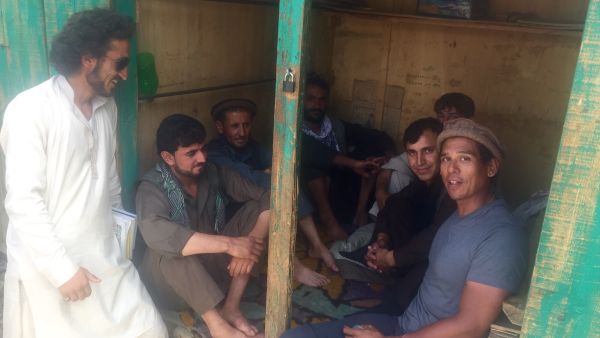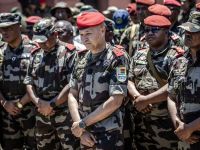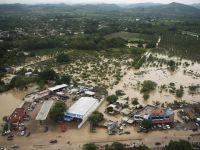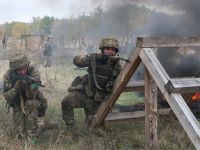Fifteen years after its invasion of Afghanistan, the US remains mired in war in the mountainous country. The conflict has now become the longest war in US history. Thousands of US troops and tens of thousands of Afghan civilians have lost their lives in the violence. The Taliban are resurgent. Yet a small number of intrepid American travelers still visit Afghanistan to soak up the local culture and hike in the country’s spectacular mountain ranges.
Al Bawaba spoke with three American adventurers who recently visited Afghanistan’s Badakhshan Province. These are their stories.
Ten days in the mountains with nomadic Kyrgyz herdsmen
Brendon Kahn, 25, spent two weeks in northeastern Afghanistan in July. Kahn is a freelance photographer and wanted to photograph the ethnic Kyrgyz people in Afghanistan’s Wakhan Corridor, a long finger of land stretching all the way to China that was once a part of the Silk Road.

The Wakhan Corridor, in red. (map via Google Maps)
Kahn said he first became interested in the Kyrgyz when he saw a National Geographic photo essay by photographer Matthieu Paley, who documented the semi-nomadic Muslim herdsman in Afghanistan's Wakhan Corridor in 2013.
Kahn crossed into Afghanistan from the Tajikistani border town of Ishkashim. Once he was in Afghanistan, Khan hired a local fixer who said he could take him up into the mountains to meet the Kyrgyz herders, who live in yurts at extremely high altitudes.
“The Kyrgyz are a very interesting culture, and that’s what I wanted to experience and reveal while I was there,” said Khan, who lives in Oakland and is a photography student at the California College of the Arts.
From the Ishkashim border crossing, Kahn and his fixer drove southeast into Afghanistan’s Wakhan Corridor until they reached the village of Wazed, where they left the car behind and began hiking. “We were trekking for 12 hours a day, covering quite some distance,” Khan told Al Bawaba.

Above, a photo Brendon Khan took of the Pamir Mountains, using infra-red film. (courtesy Brendon Khan)
Khan relied on local porters and animals to help carry his gear up into the Pamir Mountains. He said it was necessary to bring a lot of food on the trip, because you can’t rely on the Kyrgyz to feed you enough. “They’ll offer you food, out of the goodness of their hearts, but it will be minimal at best,” said Khan.
In addition to carrying food and camping gear, Khan was also bringing photographic equipment, which included multiple cameras and ten rolls of color infrared film.
Before reaching the Kyrgyz settlements, Khan spent a day photographing Afghanistan's ethnic Wakhi people, nomadic herders who spend their summers at lower altitudes than the Kyrgyz. The Wakhi have lived in this area for 2,500 years.

A Wakhi or Kyrgyz structure in the Pamir Mountains. (courtesy: Brendon Kahn)
In total, Khan said, it took six days to reach the Kyrgyz “summer camp,” where the herdsmen spend about three months raising yaks, horses, sheep and other animals. When the summer's over, the Kyrgyz pack up their camp and go in search of new pastures for their animals.
Khan spent ten days at the Kyrgyz summer encampment, observing the herdsman and photographing their daily lives. “The Kyrgyz have a fascinating story. They live in a very remote area, and they live very hard lives. They have one of the highest infant mortality rates in the world,” Khan said.
Almost one-third of Kyrgyz children in this area die before they turn 5, according to a report by CBS News.

A Kyrgyz man who did not know his age (left) and his granddaughter (right). (courtesy: Brendon Kahn)
The ethnic Kyrgyz herders are originally of Turkish origin. They're a tiny minority in Afghanistan, numbering just 1,000-2,000. Their mountain communities in the Wakhan are “bubbles of cultural integrity,” Khan said.
Living conditions at the camp were harsh. “Every night it was extremely cold. We’re talking a base elevation, even in the passes, of 14,000-16,000 feet (4,267-4,876 meters). In the mornings it was 30 degrees [Fahrenheit, or -1 Celsius]. During the day, if the sun was out, it might get up to 65 [Fahrenheit, or 18 Celsius], but not if there were clouds or if it was snowing. And this was warmest time of the year,” he said.
Below, a video Kahn filmed in the Pamir Mountains. (Instagram/brendonkahnphoto)
The Wakhan Corridor is a bastion of conservation, Khan said, where wolves, bears and snow leopards (an endangered species) thrive. Khan said he has a background in wildlife conservation, and currently does branding for outdoor lifestyle companies to help pay the bills.
When asked if he felt unsafe during his time in Afghanistan, Khan said “absolutely not.” “It was a wonderful, beautiful place. The people could not have been more kind. The hospitality, the warmth, were remarkable. If you follow their rules and respect their customs, only good things will happen.”
Because of its remote location, the Wakhan region has escaped the worst effects of Afghanistan’s wars since 1979, according to Reuters.
But Khan said safety was definitely a concern in some areas, and that it was difficult to get concrete information about the security situation. “The Wakhan was safe, but I would feel a bit more uncertain traveling a couple hundred kilometers to the east. The security situation is not great. Every day there are reports, ‘The Afghan army takes back a village’ or ‘The Taliban move further north.’”
Khan added that because of its relative safety, the Wakhan region is being frequented more and more by European travelers who stay in guest-houses in the villages or go camping in the mountains.
“If I was European, I would have felt like I had more flexibility,” he said. But being an American is different. “The fact that you have to register [with the police] in each city or village that you visit” makes things potentially more dangerous, he said.
Below, a Wakhi boy in the Pamir Mountains. (Instagram/brendonkahnphoto)
In early August, a tourist bus in western Herat Province was ambushed by the Taliban, leaving six people wounded. There were eight Britons, three Americans and a German in the group, who were in Afghanistan on a tourist trip organized by the UK tour company Hinterland Travel.
With neither the Afghan or US governments keeping track, there are no official statistics for how many Americans go to Afghanistan every year. It's likely only a few hundred, because there's a fear of Afghanistan because of media coverage of the war there.
In reality, certain parts of the country can be accessed if travelers do their research carefully ahead of time and use common sense.
The US State Department warns against traveling "to all areas of Afghanistan" because of "the ongoing risk of kidnapping, hostage taking, military combat operations, landmines, banditry, armed rivalry between political and tribal groups, militant attacks, direct and indirect fire, suicide bombings, and insurgent attacks."
But attacks on tourists in Afghanistan are rare. The real danger seems to be for local Afghan guides. Khan wrote on his Instagram page in July that a 21-year-old tour guide he met had faced death threats from the Taliban for his work with foreigners.
Overall, there’s still “so much suffering” in Afghanistan, Khan said. “Things are only getting worse. It’s the worst it’s been in 10 or so years. But I’m just glad I got to see this tiny bastion of hope.”
Conspiracy Theories, Sheep Liver and Smuggled Vodka
Tony Gedeon, 40, visited Afghanistan for three days in July. Gedeon, who’s originally from New York, told Al Bawaba that he’s on a mission to visit every country in the world.
So naturally Afghanistan was on the list.
Gedeon was traveling in Tajikistan in July, staying in a hostel near the Afghan border. The owner of the hostel had contacts in Afghanistan, and gave Gedeon the phone number of a young Afghan Muslim teacher named Ali, who spoke English and "could help you not get lost or killed," Gedeon said.
Next, Gedeon had to obtain a visa giving him permission to enter Afghanistan. “I’d heard that the [Afghan] embassy in Khorog [a city in Tajikistan] gave visas for $200,” he said. “It’s a rip-off. For all other nationalities it’s $50 or $100, only for Americans is it $200.”
Gedeon went to the embassy and asked the Afghan consul why the visa was so expensive for US citizens. The consul replied, “Because you destroyed our country!”
After a brief lecture about how Bill Clinton, George W. Bush, the Pakistani government and “The Jews” had planned the 2001 Twin Tower attacks in New York, the consul asked Gedeon to write a letter saying he absolved the Afghan government of all responsibility for anything bad that might happen to him while traveling in Afghanistan. “It was a little absurd,” Gedeon said.
But he got his visa.

At the border crossing, Afghan officials asked him a number of questions about why he wanted to come to Afghanistan. Gedeon said he had to call Ali and have the young teacher come get him.
When Ali arrived, Gedeon was permitted to enter Afghanistan.
For the next three days, Gedeon and another traveler he’d met, a 30-year-old French adventurer, stayed at Ali's house in the Shighnan region of Badakhshan Province, exploring a nearby village and going fishing and hiking.
Below, Tony and an Afghan farmer he met while hiking. (courtesy: Tony Gedeon)

Gedeon said Ali was friendly and prepared three meals a day for his Western guests. The food was good, Gedeon said, but the water less so. “The drinking water came from a nearby stream, and there was cowshit in the stream, so I doubt it was very safe to drink.”
Gedeon said he was unable to buy bottled water anywhere in the area. He’s unsure if the stream water made him sick because he already had daily diarrhea from being in Tajikistan.
In Afghanistan, Gedeon said he didn’t feel in danger, but he also didn’t feel totally safe. “The locals look like your idea of what the Taliban look like,” he said. “They have big beards, wear wool vests and the typical Afghan hat.”
In the local market, Gedeon said Ali was proudly introducing him as “the American tourist.” This didn’t always play well: “There were some unfriendly looks,” Gedeon said. “I was a little sketched out.”
There were a few Afghan soldiers in the market, Gedeon said, but they were not a big presence.
Ali took Gedeon and the Frenchman hiking one day in some nearby mountains. The scenery was “breathtaking,” Gedeon said, and the people were friendly. “While we were up there [in the mountains], we met some shepherds who offered us food. We ate [sheep] liver, really fresh liver, with them.”
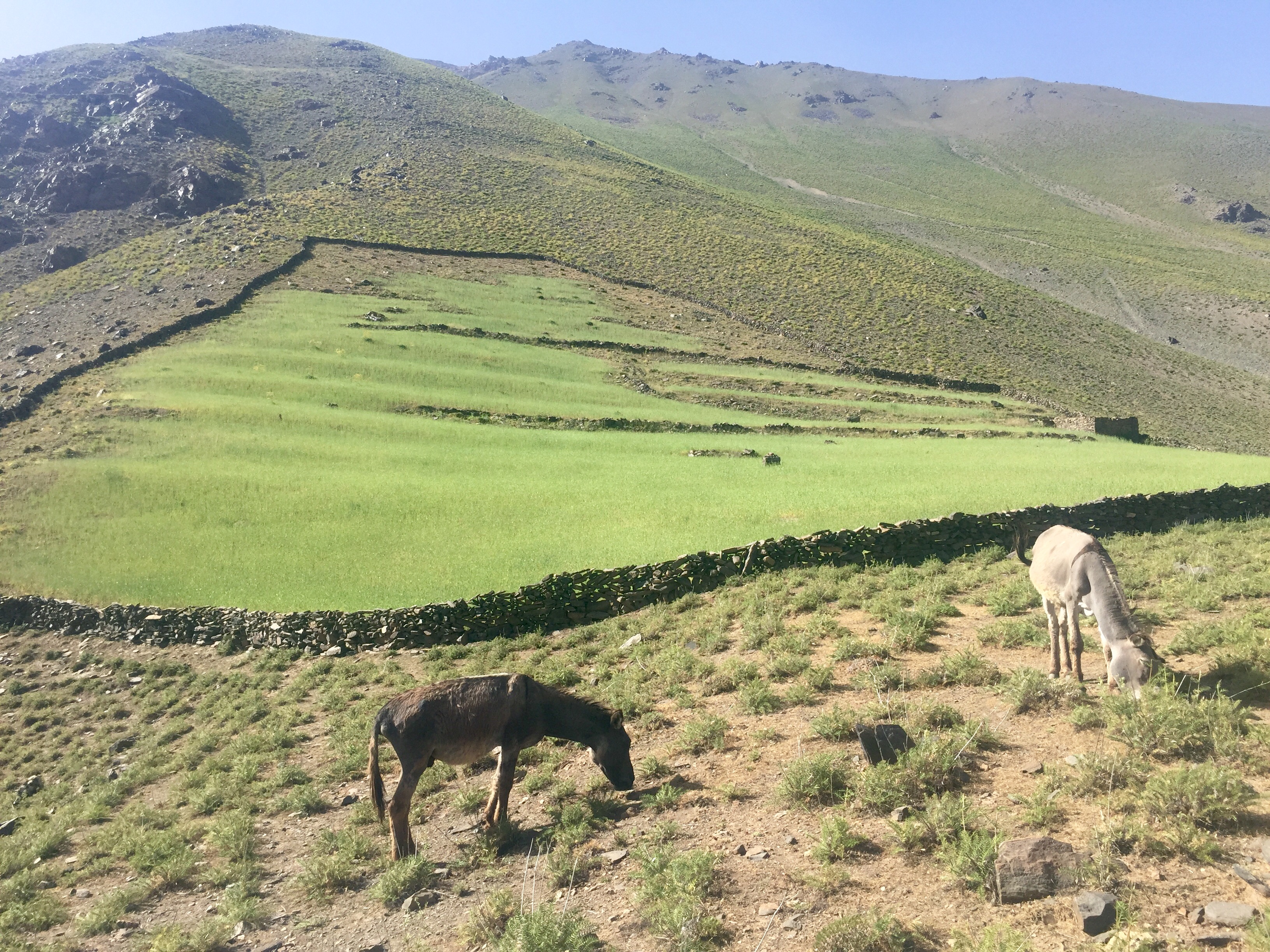
Above, rolling hills in Shignan. (courtesy: Tony Gedeon)

Above, Gedeon fishing with Ali and others in Badakhshan Province. (courtesy: Tony Gedeon)
On his final day in Afghanistan, Gedeon and his French companion were offered vodka by a group of villagers sitting under a tree in the town near Ali’s house. “It was a one-liter plastic bottle, and we drank it with lunch. We finished the whole thing. It tasted like gasoline,” Gedeon said.
Afghanistan is more than 99% Muslim, and drinking alcohol is largely forbidden. But Gedeon said he in Central Asia, a lot of the Muslims drink. “In Tajikistan, a bottle of vodka costs about $1, so the stuff we drank in Afghanistan was probably smuggled from Tajikistan,” he said.
Gedeon owned a cosmetics and raw materials company in Shanghai for years before selling it in 2013. He uses money he made in China to fund his current travels. “I’ve been a traveling nomad for the past three years,” he said.

A bit of bling in rural Afghanistan. (courtesy: Tony Gedeon)
Gedeon said he was shocked by the poverty of Afghanistan. “I was surprised how they seem to have no international help,” he said. “I know Afghanistan gets a lot of aid in terms of dollars, but they really need help in terms of infrastructure, Peace Corps, doctors, of which there are none.”
He said the infrastructure in Badakhshan Province was very bad. “The roads are all unpaved, and most of the cars are very broken-down. It was as bad as anywhere I’ve seen in West Africa.”
At the school where Ali works as a teacher, Gedeon said: “There were dirt floors, no glass in the windows, and even the English teacher there could barely speak English.”
Gedeon said he didn’t stay in Afghanistan longer than three days because there wasn’t anything else to do where he was staying, and if he traveled deeper into the country it would have been dangerous.
Bribes, bureaucracy and reckless Russians
Caroline Lupini, a 24-year-old American blogger, spent four nights in Afghanistan in July, also in Badakhshan Province. “I love to travel off the beaten track, and I want to visit every country in the world, so I’ve known for a while that I wanted to go to Afghanistan,” she told Al Bawaba.
Lupini, who lives part-time in Ann Arbor, Michigan, was traveling in Tajikistan in July when she met Cole, a 21-year-old American from Dallas who was planning to cross the border into Afghanistan. She decided to go with him.
“I got a visa from the Afghan consulate in 30 minutes, and we went to the border that same day,” said Lupini, who funds her international adventures by writing for websites like MileCards and FrugalTravelGuy that explain to travelers how to travel the world on a budget.
At the Ishkashim border crossing between Tajikistan and Afghanistan (the same crossing that Brendon Khan used), Lupini had her first encounter with Afghanistan’s notorious bureaucracy.
She and Cole had been stamped out of Tajikistan without any issues, but when they arrived to the Afghan side of the border crossing, at about 3:00 P.M., they were told it was closed for the day. “Apparently because it was Ramadan, the border closed early,” Lupini recalled.
An Afghan official told her the border would be closed for the next five days, but that he could have it opened specially for them -- for a cool $150. Since they’d already exited Tajikistan and were currently in a no-man’s land between the two countries, the pair didn’t have much choice to pay up.
“That was a pricey bribe!” Lupini remarked.
After paying off the Afghans, Lupini and Cole walked into Afghanistan’s Badakhshan Province without much of a plan. “We figured we’d find a guesthouse and use their WIFI to do more research,” Lupini said.
The pair soon found themselves in the tiny village of Ishkashim, which is just over border from Tajikistan. Ishkashim is about 69 miles (110 kilometers) south of the area where Gedeon stayed.
In the bazaar in Ishkashim, Lupini and Cole had a stroke of luck. “We met a guy named Malang Daria who we’d heard about already, because we’d read about him on travel blogs, and a tourist office in Tajikistan had given us his phone number,” Lupini said.
Daria is a famous Afghan mountaineer, best known for having been the first Afghan to summit Mt. Noshaq, a 24,500-foot (7,500 meter) peak believed to be the tallest mountain in Afghanistan.
Because Lupini and Cole wanted to do some hiking in Afghanistan, Daria would be the perfect guide.
Daria brought the two Americans to a guest-house in Ishkashim called Marco Polo. It was a small establishment, “basically just a family’s home,” Lupini said. The rate was $30 a night, which included three meals a day.
Lupini said there was an 18-year-old Russian woman staying there who was planning to hitch-hike from Ishkashim to Kabul, Afghanistan’s capital city. According to Google Maps, the trip takes 11 hours by car. The journey involves crossing areas controlled by the Taliban.
“No one wanted to let her leave because it’s so dangerous,” Lupini said. “So the Afghan family that owned the guest-house had confiscated her passport to keep her from leaving.”
When asked how local Afghans perceived the Taliban, Lupini said “it definitely seemed that they [the Taliban] were viewed as negatively by Afghan people as they are by Americans.”
Above, Lupini (fifth from left) with some local Afghan kids near Ishkashim. (courtesy Caroline Lupini)
After spending a day exploring Ishkashim, Lupini and Cole arranged to do a 23-mile hike in the storied Hindu Kush mountains, which stretch for hundreds of miles from Afghanistan eastwards through Pakistan and the disputed Kashmir region all the way to the border of China.
Lupini and Cole hired a car for the two-hour drive south, to the village of Qazi Deh, where they planned to begin the hike to Noshaq Base Camp, which is where extreme mountaineers begin the ascent up Mt. Noshaq. The trek to the base camp would take three to four days round trip, Lupini estimated.
She and Cole had arranged through Daria for a porter, who would guide them, help carry their gear, and cook them meals during the 23-mile hike.
But just as the two travelers were going to start the trek, Daria got a call from an official with the provincial government, saying the hikers needed to obtain a permit to do the hike. To get the permit, they’d have to make a 10-hour round-trip car journey to another town.
“We didn’t have that extra time to kill, so we ended up calling off the hike,” Lupini said. She and Cole resigned themselves to exploring Qazi Deh on foot and then driving back to Ishkashim, where they spent the night before leaving Afghanistan the following day.
“We would have stayed longer but there wasn’t much else to do,” Lupini said.
She said the region seemed extremely poor, even poorer than rural Tajikistan. “As soon as you cross the border, you can see the poverty [in Afghanistan] is just so bad,” she said.
“In Qazi Deh, an older lady invited us into her house for tea,” Lupini recalled. “But when we went inside, she had no tea. She had hardly anything. There were no lights in the house, and the place was pretty dirty. So she offered us some milk from a dirty pan that had bugs floating in it. We accepted so as not to be rude.”
Otherwise, Lupini said Afghanistan "seemed pretty normal," and did not feel dangerous. “It wasn’t the Afghanistan I had in my head from watching the news in the States. The people were friendly. They seemed excited to meet us.”
People washing their car near Ishkashim. (courtesy: Caroline Lupini)
Radicalism is rare in the Wakhan region, where Lupini and Cole were staying. Lupini said almost all the women she encountered wore headscarves, but wore them loosely, and she saw a few women walking in public with their hair uncovered.
Mountains near Qazi Deh. (courtesy: Caroline Lupini)
Overall, Lupini’s impression of the small part of Afghanistan she visited was that the people were exceptionally warm. “They were some of the friendliest, most generous people I’ve ever met.”
By Hunter Stuart
Contact me at hunter@corp.albawaba.com
Follow me on Twitter @hoont


